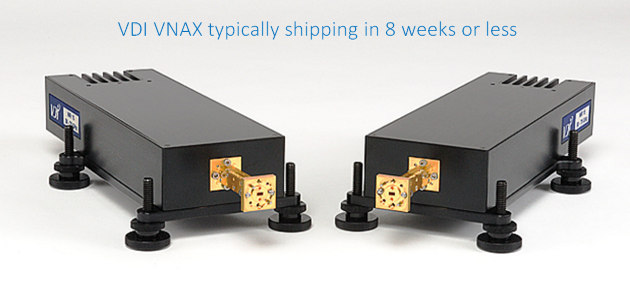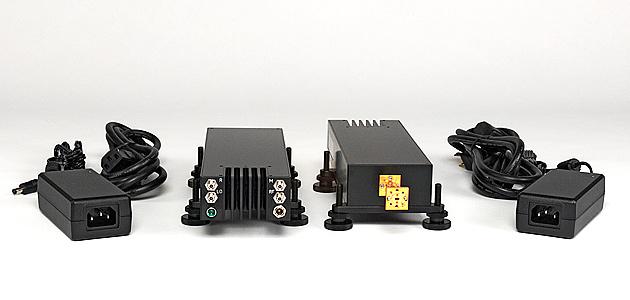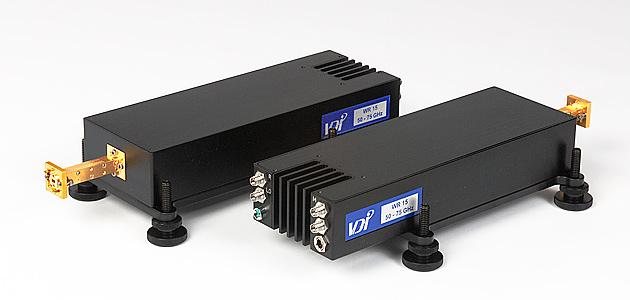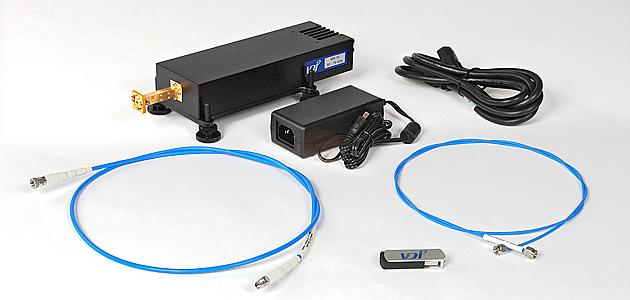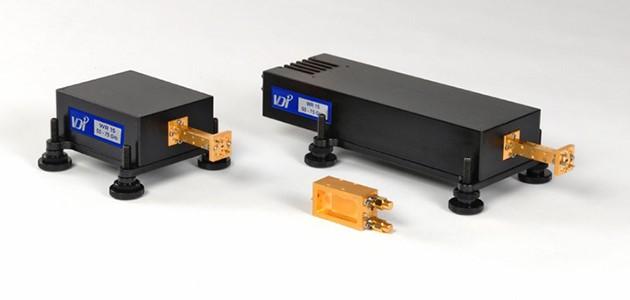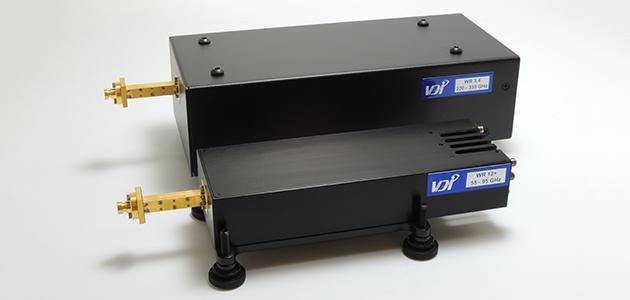ネットワークアナライザ用エクステンションモジュール(VNAX)
Virginia Diodes
概要
VDIのVNAエクステンダーは、テラヘルツ帯域への高性能ネットワークアナライザー周波数拡張を提供します。
モデルは50 GHz〜1,100 GHzをカバーし、追加の帯域が開発中です。
トランシーバー(TxRx)モジュールに加えてVDI社は特定のアプリケーションに最適化されたパフォーマンスを提供する送信(TxRef)モジュールと受信(Rx)モジュールも提供します。
これらのモジュールは高いテストポートパワーと卓越したダイナミックレンジを組み合わせて、業界をリードするパフォーマンスを提供します。
ほとんどのネットワークアナライザーと互換性がありプローブステーションやアンテナチャンバーに統合できます。パワーレベリングとスイープは、VDI社のPM5パワーメーターと併用するとでサポートされます。
オプション
- 増加したテストポートパワー(特定のバンド用)
- マイクロメーター駆動の可変減衰器(〜0-30dB)
- 1.2mから5mのケーブルで構成(標準構成は1.2m、5mオプション)
- ウェーブガイド校正キット
- 高損失環境向けの拡張ダイナミックレンジモジュール
ダウンロード
VNAX-AM (Streamline VNA to VNAX Adapter Module) Product Manual
VNAX Dual Source Option Datasheet
DOWNLOAD
仕様
WR28 ~ WR2.2
|
VNA Extension Modules General Specifications (WR28 to WR2.2) |
|||
| Description | Specification | Connector | |
| RF Input | Typical / Damage, -20 Option (Default) | 10 dBm ± 3 dB / 16 dBm | 2.9mm (f) |
| Typical / Damage, -20 Option (Default) with -5m option |
2 dBm ± 3 dB / 8 dBm | 2.9mm (f) | |
| Typical / Damage, -40 Option | 0 dBm ± 3 dB / 6 dBm | 2.9mm (f) | |
| LO Input | Typical / Damage (Default) | 10 dBm ± 3 dB / 16 dBm |
2.9mm (f) |
| Typical / Damage, -5M Option | 2 dBm ± 3 dB / 8 dBm | 2.9mm (f) | |
| IF Outputs (Reference and Measurement) |
Maximum, Direct Connection (279 MHz) | -9 dBm | 2.9mm (f) |
| Maximum, Controller (7.6 MHz) | -27 dBm | 2.9mm (f) | |
| Test Port | VDI Precision Flange | See Flange Diagram | UG-387/UM |
| Power Supply | AC Input | 100-240VAC, <3.5A, 50-60 Hz |
U.S. or E.U. |
| DC Output | 9V / 4A | 2.1mm ID x 5.5mm OD x 9.5mm (f) |
|
| Operating Temperature | Typical / Recommended | 25°C / 20-30°C | - |
| Typical Enclosure Dimensions | TxRx & TxRef Modules (in.) WR28 to WR19 |
9.5 x 3.0 x 1.5 | - |
| TxRx & TxRef Modules (in.) WR15 to WR2.2 |
8.5 x 3.0 x 1.5 | - | |
| TxRx & TxRef Modules (in.) WR28 to WR19, -Atten Option |
問合せください | - | |
| TxRx & TxRef Modules (in.) WR28 to WR19, -Atten Option |
8.5 x 3.0 x 1.5 | - | |
| Rx Modules (in.) | 3.75 x 3.0 x 1.5 | - | |
| Typical Weight | TxRx & TxRef Modules (lbs.) | 4 | - |
| Rx Modules (lbs.) | 2 | - | |
WR1.5 ~ WR0.65
|
VNA Extension Modules General Specifications (WR1.5 to WR0.65) |
|||
| Description | Specification | Connector | |
| RF Input | Standard Frequency Input (Typical / Damage) | 10 dBm ± 3 dB / 16 dBm | 2.9mm (f) |
| Standard Frequency Input (Typical / Damage) with -5m option |
2 dBm ± 3 dB / 8 dBm | 2.9mm (f) | |
| High Frequency Input (Typical / Damage) | 0 dBm ± 3 dB / 6 dBm | 2.9mm (f) | |
| LO Input | Typical / Damage (Default) | 10 dBm ± 3 dB / 16 dBm |
2.9mm (f) |
| Typical / Damage, -5M Option | 2 dBm ± 3 dB / 8 dBm | 2.9mm (f) | |
| IF Outputs (Reference and Measurement) |
Maximum, Direct Connection (279 MHz) | -9 dBm | 2.9mm (f) |
| Maximum, Controller (7.6 MHz) | -27 dBm | 2.9mm (f) | |
| Test Port | VDI Precision Flange | See Flange Diagram | UG-387/UM |
| Power Supply | AC Input | 100-240VAC, <3.5A, 50-60 Hz |
U.S. or E.U. |
| DC Output | See VDI-175 Datasheet | ||
| Operating Temperature | Typical / Recommended | 25°C / 20-30°C | - |
| Typical Enclosure Dimensions | TxRx & TxRef Modules (in.) |
11 x 5 x 3 | - |
| Rx Modules (in.) |
8 x 5 x 3 | - | |
| Typical Weight | TxRx & TxRef Modules (lbs.) | 9 | - |
| Rx Modules (lbs.) | 4 | - | |
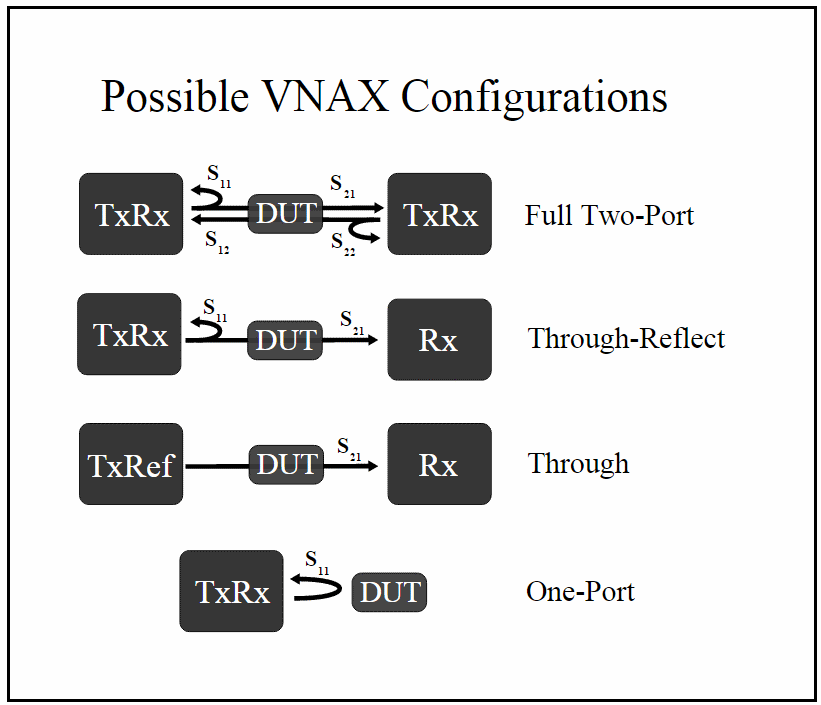
仕様一覧
|
Vector Network Analyzer (VNA) Extenders - Summary of Specifications |
|||||||||
| Waveguide Band |
Frequency Coverage (GHz) |
Dynamic Range (BW=10Hz,dB) |
Test Port Power (dBm typical) |
Stability | Test Port Input Limit (estimate, dBm, damage) TxRx, TxRef † |
Directivity (dB) | |||
| Standard | Extended‡ | Typical |
Minimum |
Magnitude (±dB) | Phase (±deg) |
||||
| WR28 | 26-40 | - | 120 | 110 | 13 | 0.15 | 2 | 33 | 30 |
| WR19 | 40-60 | - | 120 | 105 | 13 | 0.15 | 2 | 31 | 30 |
| WR15 | 50-75 | 47-77 | 120 | 110 | 13 | 0.15 | 2 | 30 | 30 |
| WR12 | 60-90 | 55-95 | 120 | 110 | 13 | 0.15 | 2 | 30 | 30 |
| WR12 SE Option | 60-90 | 55-90 | 120 | 110 | 13 | 0.15 | 2 | 30 | 30 |
| WR10 | 75-110 | 67-115 | 120 | 110 | 18 | 0.15 | 2 | 30 | 30 |
| WR10 SE Option |
75-110 | 67-110 | 120 | 110 | -1 | 0.15 | 2 | 20 | 30 |
| WR8.0 | 90-140 | - | 120 | 110 | 6 | 0.15 | 2 | 30 | 30 |
| WR6.5 | 110-170 | - | 120 | 110 | 13 | 0.25 | 4 | 30 | 30 |
| WR5.1 | 140-220 | - | 120 | 110 | 6 | 0.25 | 4 | 30 | 30 |
| WR4.3 | 170-260 | - | 115 | 110 | -2 | 0.3 | 4 | 28 | 30 |
| WR3.4 | 220-330 | - | 115 | 105 | 1 | 0.3 | 6 | 26 | 30 |
| WM-710 (WR2.8) |
260-400 | - | 100 | 80 | -10 | 0.5 | 6 | 16 | 30 |
| WM-570 (WR2.2) |
330-500 | 325-500 | 110 | 100 | -3 | 0.5 | 6 | 10 | 30 |
| WM-380 (WR1.5) |
500-750 | - | 100 | 80 | -25 | 0.4 | 4 | -3 | 30 |
| WM-250 (WR1.0) |
750-1100 | - | 65 | 45 | -30 | 0.5 | 6 | -3 | 30 |
| WM-164 (WR0.65*) |
1100-1500 | - | 60 | 40 | -45 | 1 | 20 | -3 | 30 |
*WM164 (WR0.65) performance is specified for a TxRx-Rx configuration using external synthesizers. Performance of a TxRx-TxRx configuration is estimated to have a ~15 dB degradation of dynamic range and may additionally require the use of a mmWave controller.
†Test Port Input Powers exceeding the peak Test Port Power of the TxRx or TxRef module will compress the module.
General Notes:
Extension modules are compatible with all modern VNAs. Please consult with VDI to discuss VNA and module configurations that will yield the best performance for your application.
Technical Notes:
1. Test Port Power is typical, reduced power is possible at band edges. Range is measured on PNA/PNAX front-panel with internal synthesizers, using a controller can reduce DR by ~5-10 dB.
2. Stability is specified for 1 hour after system warm-up, in stable environment with ideal cables.
3. Specifications assume a through measurement with two TxRx heads.
4. Specifications are measured on a Keysight PNA/PNAX with front panel connection at 25°C typical.
5. The dynamic range (RBW 10 Hz) is measured by first connecting two TxRx heads together and normalizing the un-calibrated S21 & S12. The heads are then disconnected and terminated with a waveguide short. The rms of the measured S21 & S12 give the system dynamic range.
6. Typical Module Dimensions exclude testport (2" standard testport for all modules except WM250 (WR1.0), where a 1" testport is used)
‡Where noted, Extended Frequency Coverage applies; module performance within the standard band conforms to standard specifications while performance in the extended regions can be degraded as follows:
-The minimum and typical dynamic range is degraded by 10dB or less, compared to the specification for the standard band.
-The test port power typical across the extended band is degraded by 5 dB or less compared to the specification for the standard band.

